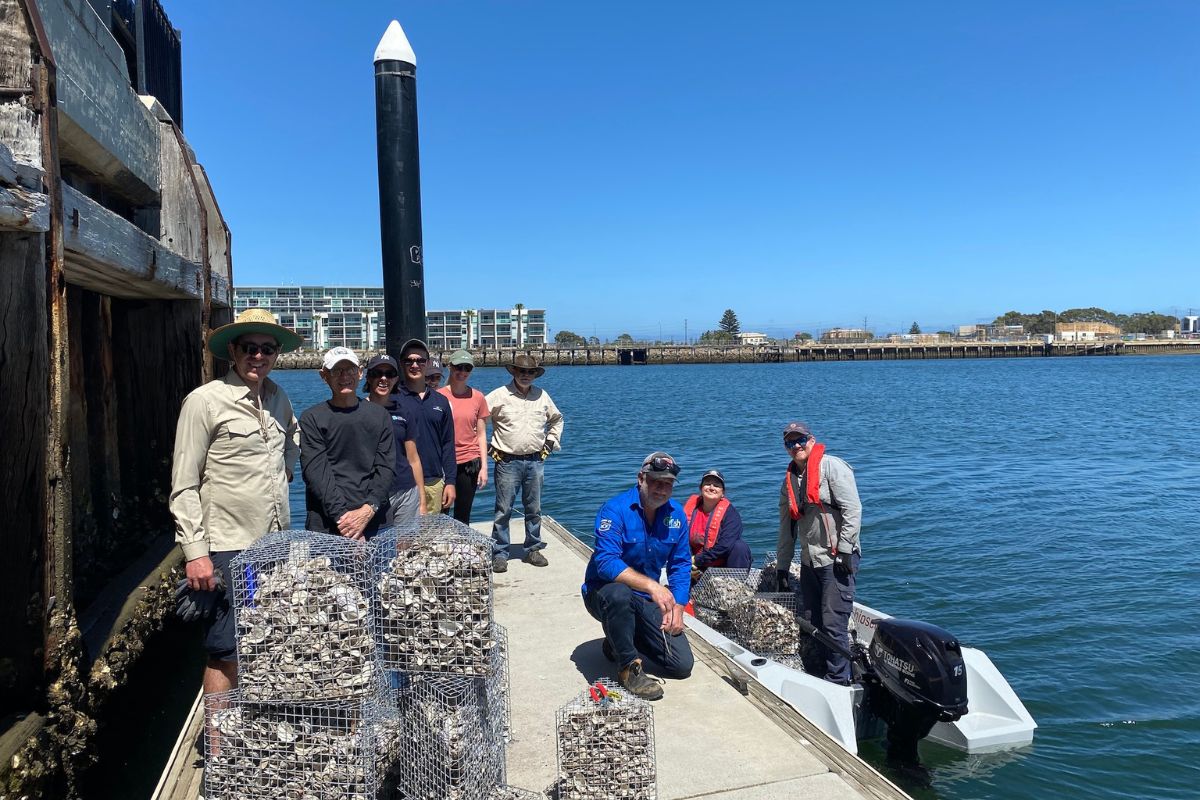Hundreds of shellfish reefs ready to tackle algal bloom
South Australians are rapidly building new shellfish reefs to install in local waters in a bid to fight back against the toxic algal bloom over summer.

As tonnes of dead sea creatures affected by the toxic algal bloom continue to wash up on the state’s beaches, fish habitat charity OzFish is rapidly building 1,200 shellfish reef modules ready for deployment in the Port River over summer.
OzFish SA Project Manager Brad Martin said numerous volunteers were building the reefs that act as a natural algal bloom defence by improving water quality and marine biodiversity.
He said the reefs would restore the native oyster population to Port River estuary following two centuries of “destructive dredge fishing” that has left reefs functionally extinct across South Australia.
The move followed OzFish’s successful 2022 trial where 70 Robust Oyster Baskets (ROBs) were placed in the Port River estuary backed by $181,500 funding under the Federal Government’s Urban Rivers and Catchments Program.

“Oysters are filter feeders so by filtering the water they are improving water quality — it’s taking the algae out of the water column and whatever they don’t eat transfers to the seafloor which also improves water quality,” Martin said.
“They also make really great fish habitats for blue swimmer crabs, snapper and King George whiting because they are structurally complex so there are benefits to making more.”
You might like
More than 50 volunteers built 600 of the ROBs from 12 tonnes of recycled oyster shells at a workshop last month, the reefs designed to attract oyster larvae that would make a home in the shells.
The project coincides with the State and Federal Government’s announcement in August of a $28 million algal bloom package to support businesses, citizen science research and community clean-up efforts.
Governments said $850,000 would fund 15 oyster reef restoration sites across Yorke Peninsula, Eyre Peninsula and Kangaroo Island as part of a three-year project to help communities respond to the algal bloom.
A Department for Environment and Water (DEW) spokesperson said the SA reef restoration sites or funding allocations were still to be determined.
“More information on environmental projects will be included in the State Government’s algal bloom summer plan, which will be released this month,” the DEW spokesperson said.
OzFish is hoping to secure enough government funding in the coming months to expand its operations and fund the deployment of additional reef modules.
“We’re quite hopeful that we get some government funding to continue and upscale what we do in light of the algal bloom,” Martin said.
OzFish planned to deploy 18 tonnes of recycled shell material over summer to restore reefs that once occupied more than 800 square kilometres of South Australia’s coastline.
Stay informed, daily
“Something like 99 per cent of our native oyster reefs are functionally extinct — the dragging chains along the bottom of the ocean have taken all the shells and all the oysters out of the environment,” Martin said.
He said there had been growing engagement from the community to assist with the algal bloom.
“We’ve seen a lot more people get involved with OzFish which is fantastic, and it also means our current reef restoration project is well ahead of schedule,” Martin said.
“It’s become a real motivator to try and help the situation — largely because we are seeing all of these dead fish and sea foam washing up on our beaches.”
Martin said it was not unusual to come across dead animals as marine life continued to wash up along SA beaches.
On the weekend, a second green sea turtle was found near Grange jetty, the creature had died and locals on social media called for more information on how to get sea life rescued.
“The turtle was immediately assessed by National Parks and Wildlife Services staff and, due to it being in an advanced state of decomposition, was promptly buried as it was unsuitable to be collected for testing,” a DEW spokesperson said.

Another green sea turtle was found on Grange Beach on September 3 but a local resident managed to enlist the help of a vet and the turtle was later transferred to the Adelaide Zoo animal health centre.
A DEW spokesperson said that current evidence suggested the algal bloom does not present a direct risk to animals that breathe air with lungs.
“Anyone who discovers sick or dead wildlife (including marine mammals and wild birds) is to call the Emergency Animal Disease Hotline on 1800 675 888 and to report fish deaths to FISHWATCH on 1800 065 522.”









